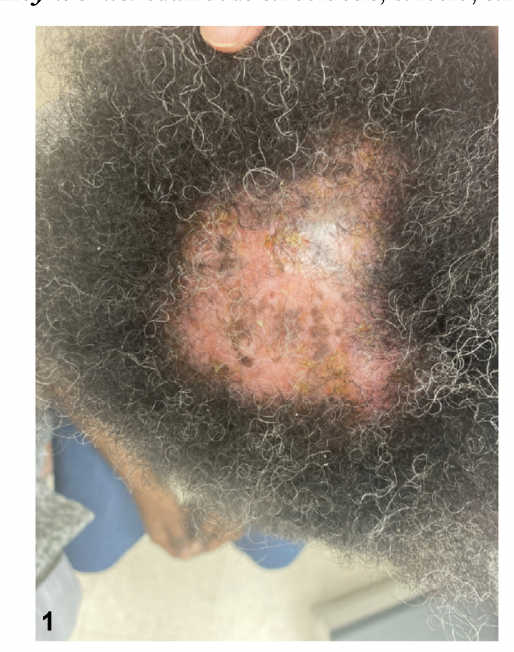Sarcoidosis as a Cause of Scarring Alopecia
Scarring Alopecia Due to Sarcoidosis Mimicking Central Centrifugal Cicatricial Alopecia, Discoid Lupus, Folliculitis Decalvans and Dissecting Cellulitis.
I was really interested to read a case report by Baker and colleagues of a 48 year old female who presented with short 1 year or so history of hair loss along with scalp itching and crusting and drainage. Her examination confirmed that the hair loss was scarring in nature. There was a rim of hyperpigmentation. Her history was notable for uveitis (a type of eye inflammation). Her scalp biopsy showed features confirming sarcoidosis
Scarring alopecia due to sarcoidosis. Image from Barker C et al. Scarring alopecia and scalp pruritus. JAAD Case Rep. 2022 Nov 2;30:134-136. doi: 10.1016/j.jdcr.2022.10.021. eCollection 2022 Dec. Image used with creative commons license.
Histology from scalp in patient with sarcoidosis. Image from Barker C et al. Scarring alopecia and scalp pruritus. JAAD Case Rep. 2022 Nov 2;30:134-136. doi: 10.1016/j.jdcr.2022.10.021. eCollection 2022 Dec. Image used with creative commons license.
Histology from scalp in patient with sarcoidosis showing non caseating granulomas typical of the disease. Image from Barker C et al. Scarring alopecia and scalp pruritus. JAAD Case Rep. 2022 Nov 2;30:134-136. doi: 10.1016/j.jdcr.2022.10.021. eCollection 2022 Dec. Image used with creative commons license.
Comment
Scalp sarcoidosis is quite uncommon. In fact, there has been less than 50 cases published in the medical literature so far. Many of these cases have been African American women who have systemic involvement. In the medical literature, 87% of patients with scalp sarcoidosis were African American with only 2 cases reported in Caucasians. Scalp sarcoidosis may be non-scarring or scarring. It is more likely to be a scarring alopecia and less likely to be non-scarring alopecia.
Clinically, the lesions often have an orange color. I note in this patient above that the scalp had a bit of an orange color. But the orange color is not always present in scalp sarcoid- especially in darker skin types. It’s important to realize that scalp sarcoidosis truly is one of the great imitators and can take on many many different appearances! and may look very similar to lichen planopilaris, discoid lupus, pseudopelade, central centrifugal cicatricial alopecia, acne keloidalis, folliculitis decalvans, necrobiosis lipoidica, scleroderma or even alopecia areata at first glance. Some present like diffuse scaling and some present with ulcerations.
If interested, please do check out an article from several years ago about scalp sarcoidosis. It summarizes alot fo the key aspects of the condition.
REFERENCE
Barker C et al. Scarring alopecia and scalp pruritus. JAAD Case Rep. 2022 Nov 2;30:134-136. doi: 10.1016/j.jdcr.2022.10.021. eCollection 2022 Dec.
This article was written by Dr. Jeff Donovan, a Canadian and US board certified dermatologist specializing exclusively in hair loss.




